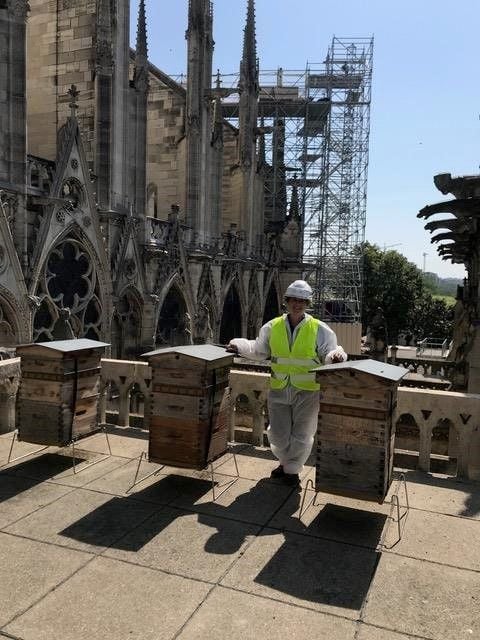Lead From Notre-Dame Fire Discovered in Parisian Beehives
The findings indicate that honey can provide important evidence of environmental pollution, scientists say
/https://tf-cmsv2-smithsonianmag-media.s3.amazonaws.com/filer/fb/f4/fbf47379-5bb3-475b-a745-d7d0a73c65a7/gettyimages-1137448781.jpg)
Last April, a major fire destroyed the spire and much of the roof of the Notre-Dame Cathedral in Paris. As the medieval structure burned, more than 450 tons of lead melted, sending dangerous particles up in smoke. As Meilan Solly reported for Smithsonian magazine at the time, many schools were temporarily closed over concerns about lead poisoning, and city workers in protective gear were employed to spray neighborhoods with lead-absorbing gel, among other measures.
As the New York Times reported last fall, scientists are still working to understand the extent of pollution: in city streets, primary school buildings and soil. Now, scientists can add urban beehives to the list, thanks to a new study published in Environmental Science & Technology Letters.
University of British Columbia researchers Kate Smith and Dominique Weis and a team of scientists collected 36 honey samples from urban beehives in Paris in July 2019, according to a statement. They found that honey from hives downwind of Notre-Dame had lead concentrations on average four times higher than samples collected in nearby suburbs, and up to three and a half times higher than the typical amount for Parisian beehives before the fire.
If you’ve eaten Parisian honey in the last year, don’t fret. Lead concentrations levels for all honey sampled fell within the European Union’s limits for safe consumption, the researchers say. The highest concentration, at 0.08 micrograms per gram, was discovered in a hive less than three miles west of the Cathedral. For comparison, the EU’s highest allowable rate of lead in consumable products is 0.10 micrograms per gram.
“The highest levels of lead that we detected were the equivalent of 80 drops of water in an Olympic sized swimming pool,” says Weis in a statement. “So even if the lead is relatively elevated, it’s still very low.”
As Elian Peltier notes in the Times, the study is “one of the first to explore the relationship between pollution from the fire and its impact on residents through a product they can ingest directly.”
Urban beekeeping has become a popular trend in Paris and other major cities, Peltier reports. In fact, the 180,000 bees that live on the roof of Notre-Dame managed to survive the fire unscathed, as Brigit Katz reported for Smithsonian magazine last year.
Researchers compared the samples collected in Paris and its suburbs to honey samples from the Auvergne-Rhône-Alpes region in France, per the statement.
As Stephanie Pappas reported for Live Science last year, construction with lead has been a common practice since antiquity. Medieval and nineteenth century builders constructed Notre-Dame’s spire and roof out of timbers covered with thin panels of lead. Experts estimate that several hundred tonnes of lead were used in the construction, per the statement.
As Weis tells the Times, the researchers say their study shows how honey can provide important indicators of pollution. Honeybees tend to forage within a one-to-two mile range from their hives, so their honey can serve as a kind of snapshot of their local environment, reports Eric Mack for Forbes.
“We were able to show that honey is also a helpful tracer for environmental pollution during an acute pollution event like the Notre-Dame fire,” says Weis in the statement. “It is no surprise, since increased amounts of lead in dust or topsoil, both of which were observed in neighbourhoods downwind of the Notre Dame fire, are a strong indicator of increased amounts of lead in honey.”
/https://tf-cmsv2-smithsonianmag-media.s3.amazonaws.com/accounts/headshot/nora.png)


/https://tf-cmsv2-smithsonianmag-media.s3.amazonaws.com/accounts/headshot/nora.png)